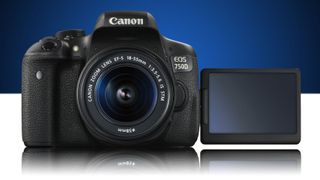Canon's new 750D (T6i)/760D (T6s) D-SLR double-act targets novices and enthusiasts
We knew a Canon D700 replacement was due, but we were expecting one camera, not two

Canon's announcement of two new cameras is just one part of the story. The other is that they use a new 24-megapixel sensor, made by Canon, which features a new version of its Hybrid CMOS AF system.
This uses phase-detection 'focusing' pixels spread across the sensor to aid faster autofocus in live view mode and when shooting movies. This latest Hybrid CMOS AF III in the 750D and 760D has more focusing pixels arranged in a more regular array, and Canon says it's about 4x faster than version II (used in the EOS 100D) and two generations ahead of the original Hybrid CMOS AF system in the EOS 700D.
Pixel power
The 24-megapixel sensor is especially interesting because this gives the 750D and 760D parity with rival Nikon D-SLRs like the D3300 and D5500. It's also a sign that Canon could be pensioning off the venerable 18-megapixel CMOS sensor still used in the 700D and EOS 100D.
The increase in resolution hasn't harmed the ISO range, though, which goes from ISO 100-12800 (25,600 in 'expanded' mode). The processing is handled by Canon's DIGIC 6 processor, a step up from the DIGIC 5 processor used in the 100D and 700D.
Both cameras offer 5fps continuous shooting and Canon's more powerful 19-point AF system (all cross-type), compared to the 9-point AF on the existing entry-level models.

Round the back, they both have articulating 3-inch touch-screen displays with a resolution of 1,040,000 dots, and both cameras can shoot full HD movies at 30fps, 25fps and 24fps. They also feature Canon's new Flicker Detection technology, first seen in the EOS 7D Mark II, for more reliable exposures under artificial light.
EOS 750D vs EOS 760D
So what's the difference? It's all about the design rather than the features. Both cameras will be part of Canon's entry-level EOS line-up, but they're aimed at different kinds of user.
Get daily insight, inspiration and deals in your inbox
Get the hottest deals available in your inbox plus news, reviews, opinion, analysis and more from the TechRadar team.
The EOS 750D is aimed at beginners who want the reassurance of automatic modes and simpler controls of the kind they might be used to on a compact camera.

The EOS 760D, however, is designed for enthusiasts who want more creative and manual control. This is the one to choose if you already know the basics and want to move on.
There's little difference in the size and weight, but the 760D swaps the mode dial over from the right side of the camera to the left to make room for a mono status LCD. This displays key shooting information in a clearly visible way without the need to check the more power-hungry LCD display on the back.
The 760D also has a second control dial on the rear of the camera. This makes it changing key camera settings much quicker, especially when shooting in the semi-automatic or manual modes where you want to adjust the shutter speed and lens aperture independently.
Price and availability
Although the 760D is for more advanced users, the prices are not that different. The EOS 760D will cost £650/US$850 (about AU$1086), body only, while the EOS 750D will cost £600/US$750 (about AU$958) body only or £690/US$900 (about AU$1150) with Canon's EF-S 18-55mm f/3.5-5.6 IS STM kit lens. Both cameras go on sale from April 2015.
Canon says that they're additions to the Canon range rather than replacements, and they they are designed to slot in between the EOS 700D and EOS 70D.
Putting aside any potential bafflement over which model to buy, and why there are two at all, the EOS 750D and 760D do represent a real step forward, with a newer, higher resolution sensor and much improved autofocus – we look forward to giving them a proper test.
